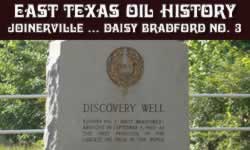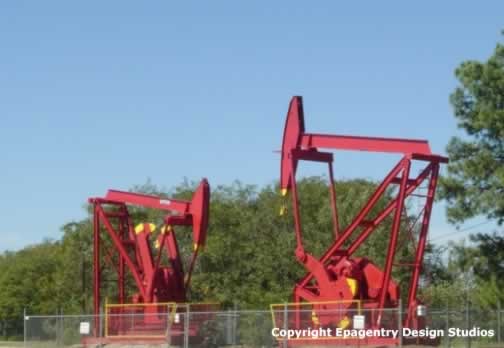East Texas Oil & Gas Industry
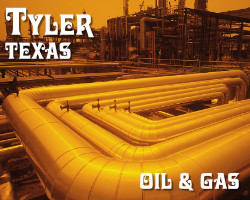 |
The East Texas area supports a large number of oilfield jobs and energy careers in the petrochemical, natural gas, drilling and refining business sectors.
A strong Texas economy has kept oil job search and oil field employment stable.
Those looking for jobs will find the Texas workforce consists of thousands of oilfield rig mechanics, welders, roughnecks, roustabouts, drillers, truck drivers, wireline operators, electricians, seismologists, petroleum engineers, geologists, and dozens more oil & gas jobs in the Texas oilfields.
Tyler is positioned in a lucrative energy drilling and production area, and is located between the Barnett Shale and the Haynesville - Bossier Shale natural gas plays.
East Texas energy employers include a wide array of companies such as Halliburton, BJ Services, Schlumberger, Chesapeake Energy Corporation, Baker Petrolite, Cudd Pressure Control, Eastman, E.O.G. Resources, XTO Energy, Weatherford International, East Texas Oil & Gas, Tyler Oil & Gas Co., Carr Resources, Mewbourne Oil Company, LandTrac, Navidad Resources, and hundreds of other small, and large, corporations.
 |
Delek Refining is located in the north section of Tyler at 425 McMurrey Drive, and employs more than 300 workers. The crude oil throughput capacity is 75,000 barrels per day, with products transported by truck and rail.
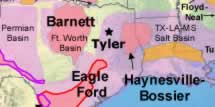 Tyler is positioned between the Barnett Shale and the Haynesville - Bossier natural gas plays |
The Longview MSA had a workforce in 2016 of 15,900 in mining and construction, while Tyler had 6,300 in natural resources and mining reported in November of 2016.
The oil industry spans a wide spectrum of energy-related businesses and occupations, including geophysical operations, exploration, oil drilling, production, oil transportation, natural gas pipelines, oil land leasing, oilfield service, refining and allied oilfield businesses.
Oil Industry Impact and Significance in East Texas
The East Texas oil and gas industry dates from the 1930s, and continues to this day to be an important part of the economy and job market of Tyler, as well as Longview, Kilgore, Marshall, Gladewater, Jacksonville, Henderson and other cities and towns.
In 2023, oil and gas royalties continue to be significant, and oil and gas investments remain strong. The State's signature crude oil type, West Texas Intermediate (WTI), remains the major benchmark of crude oil in the Americas.
The oil industry in Texas remains a vital element in our nation's energy exploration and production.
Haynesville Shale
The Haynesville formation is a layer of sedimentary rock more than 10,000 feet below the surface of the Earth in the area of northwestern Louisiana, southwestern Arkansas and eastern Texas.
Development of the Haynesville - Bossier Shale is providing additional impetus to exploration, drilling and production, and the creation of jobs and employment opportunities in the oil industry.
The most active areas have been in Caddo, Bienville, Bossier, DeSoto, Red River and Webster Parishes of Louisiana, plus adjacent areas in southwest Arkansas and East Texas. The Haynesville Shale has been estimated to be the largest natural gas field in the contiguous 48 states, with an estimated 250 trillion cubic feet of recoverable natural gas.
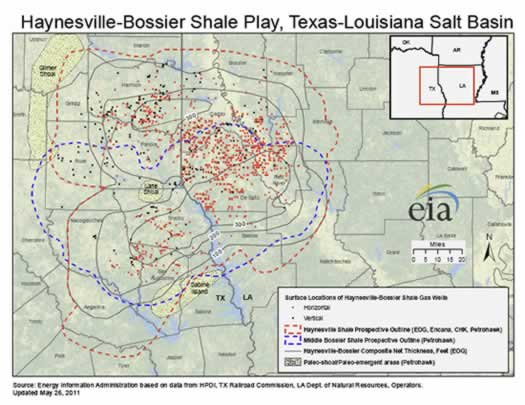 Map of the Haynesville - Bossier Shale Play in Texas and Louisiana courtesy of the U.S. Energy Information Administration |
Numerous energy companies are working explore and develop the shale formation, and drill for natural gas based on findings indicating a potentially large supply of gas trapped in the shale.
The Haynesville Formation was named after the town of Haynesville in Claiborne Parish, Louisiana. Geologists identified the Haynesville Formation over 60 years ago, and classified it as a rock formation formed during the Upper Jurassic period.
The Barnett Shale
Just west of the Tyler area in North-Central Texas lies the Barnett Shale, a hydrocarbon-producing geological formation of great economic significance to Texas. It consists of sedimentary rocks and the productive part of the formation is estimated to stretch from the city of Dallas west and south, covering 5,000 square miles and at least 24 counties.
Experts claim that the Barnett Shale is the largest onshore natural gas field in the United States. The field name for the productive portion of the Barnett Shale formation has been designated as the Newark, East Field by the Texas Railroad Commission.
The Barnett Shale is located in 24 Texas counties, listed below, as shown in the map of the Barnett Shale.
| Archer Bosque Clay Comanche Cooke Coryell Dallas Denton Eastland Ellis Erath Hamilton Hill Hood Jack Johnson Montague Palo Pinto Parker Shackelford Somervell Stephens Tarrant Wise |
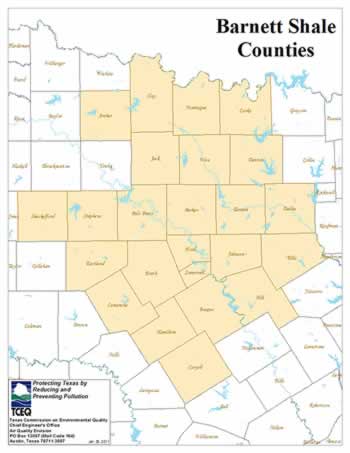 Map of the Barnett Shale counties in Texas courtesy of the Texas Commission on Environmental Quality |
Industry Connections
 |
Our connection with the oil industry stretches back to Louisiana, where we worked in the oil business technology field for over 25 years.
So our interest in this industry has been strong, and remains so, and we have a keen interest in the history of oil and gas in Tyler and all of East Texas, and the future of energy exploration, drilling, production, and pipelines.
History of the Oil & Gas Industry in East Texas
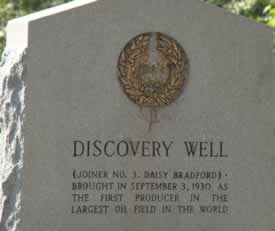 Marker at Joinerville Texas "Discovery Well ... Joiner No. 3 Daisy Bradford brought in September 3, 1930 as the first producer in the largest oil field in the world" |
The history of oil and gas exploration in Texas is a long one, dating from the first major discovery at Corsicana in 1894. Years later, the Lucas No. 1 well blew at Spindletop near Beaumont in 1901 and the industry took another huge step forward in becoming a dominant feature in the Texas economy and lifestyle.
In October 1930, the Daisy Bradford No. 3 well blew in Rusk County close to Joinerville and Turnertown, opening the East Texas Oil Field.
This giant East Texas oil field extended into parts of Smith, Upshur, Gregg, Cherokee and Rusk counties, ultimately with 30,340 historic and active oil wells. It became the largest oil field in the U.S. outside of Alaska.
The discoveries and production of oil have led to the creation of many Texas towns, and to the organization of companies which have become national and international players in the oil industry.
click for more about the East Texas Oil Field
Texas Oil and Gas Museums
When visiting East Texas, we recommend touring the renown East Texas Oil Museum in Kilgore, located at Highway 259 at Ross Street, on the campus of Kilgore College.
Those with interests in oil & gas history should also visit the Gaston Museum in Joinerville, close to the Daisy Bradford No. 3 well. When traveling in West Texas, be sure to see the Permian Basin Museum in Midland.
For more on the history of the oil and gas industry in Texas, we encourage a visit to the Texas Almanac published by the Texas State Historical Association.
Lignite Coal Mining in East Texas
Texas has more than 24 billion tons of lignite coal that can be recovered through strip mining technology. At current rates of production, Texas' coal supply will last about 400 years. Today Texas is the nation's 5th leading producer of coal, 99% of which is lignite.
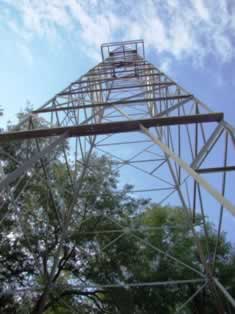 |
Eleven large strip mines operate in texas, mining coal that is burned for "mine-mouth" electric power generation.
Texas ranks first in the nation in coal consumption for electricity generation.
Texas has the nation's 8th largest mining industry, providing more than 14,000 direct jobs and over 225,000 indirect jobs. Each year, the Texas lignite mining industry spends in excess of $100 million on land restoration and other environmental procedures.
Mines are located in Harrison County, Rusk County, Titus county and several other Texas counties.
Several mining operations are located between Marshall, Tatum and Henderson in East Texas.
Oil & Gas Photo Gallery
Shown below are a few quick images of East Texas oil and gas operations, and history ...
Producing oil well, Van, Texas (Staff Photo) |
Snavely #1 - The Gladewater Discovery Oil Well
On April 7, 1931, this wildcat well drilled by Selby Oil and Gas Company
of Tulsa, OK,
came-in. It was located in the Sabine River bottom
one mile south of Gladewater.
It connected Gladewater to the vast East Texas oil field stretching from
Longview's Lathrop Well to Kilgore's Crim well
Gladewater Heritage Society Marker - Downtown Gladewater, Texas
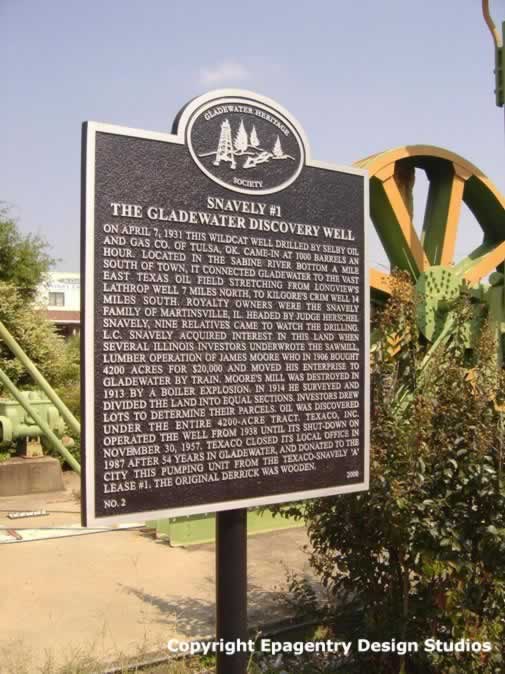
Plaque commemorating the Daisy Bradford #3 Well
of the Great East Texas Oil Field near Joinerville, Texas
Donated by the Hunt Oil Company, Ray L. Hunt, Chairman
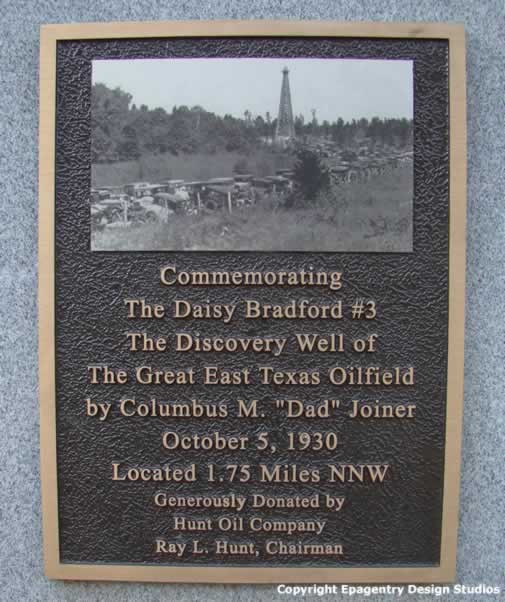
Oil field near Tyler, Texas - Historic Postcard
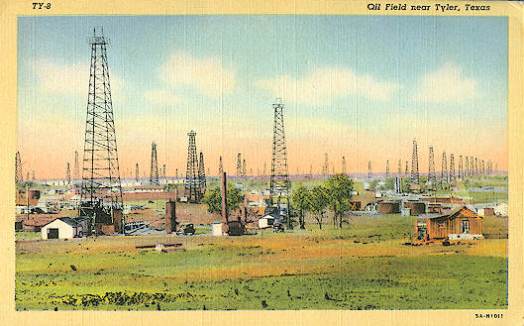
Oil Derricks in Downtown Kilgore, Texas
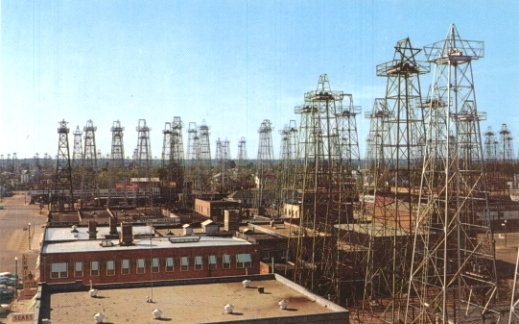
Booth's Tourist Court, Longview, Texas, on U.S. 80
"Center of Largest Oil Field in the World"
90 modern cottages - free radio - fans & garage - reasonable rates - second guest free
(from the collection of the author)
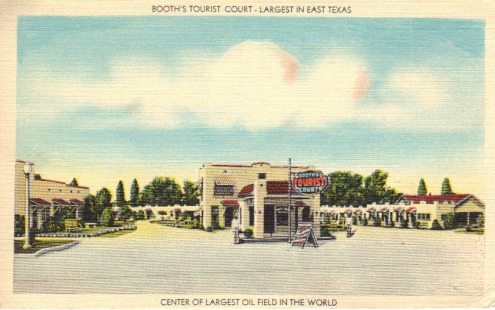
Energy Blogs
Texas Railroad Commission Links
- Haynesville Shale
- Barnett Shale
- Texas Oil & Gas Online Production Queries
- Texas Oil & Gas Operator Directory
- Texas Railroad Commission Website
Oil Information
Texas Energy Facts
- Texas is the top crude oil- and natural gas-producing state in the nation. In 2022, Texas accounted for 42% of the nation's crude oil production and 27% of its marketed natural gas production.
- Texas has the most crude oil refineries and the most refining capacity in the nation. The state's 32 petroleum refineries can process a combined total of more than 5.9 million barrels of crude oil per calendar day—one-third of the nation's total refining capacity.
- In 2022, Texas generated 26% of all U.S. wind-sourced electricity, leading the nation for the 17th year in a row. Wind power surpassed the state's nuclear generation for the first time in 2014 and exceeded coal-fired generation for the first time in 2020.
- In 2022, Texas produced more electricity than any other state and generated twice as much as second-place Florida. Texas accounted for more than 12% of the nation's total electricity net generation that year.
- Texas leads the nation in energy consumption across all sectors and is the largest energy-consuming state in the nation. The industrial sector, including the state's refineries and petrochemical plants, accounts for more than half of the state's energy consumption and for 23% of the nation's total industrial sector energy use.


